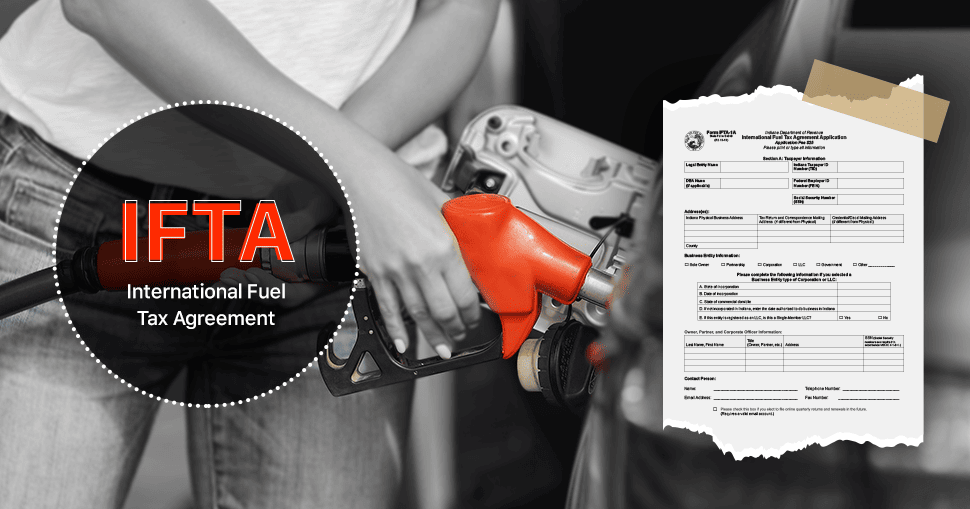IFTA – International Fuel Tax Agreement

IFTA or International Fuel Tax Agreement is an agreement for simplifying collection and distribution of fuel tax in 48 states of the USA and Canadian province. It is not mandatory for Canadian territory, Alaska, District of Columbia and Hawaii but all of Canada and Alaska have them. IFTA collects all the fuel data and files a quarterly tax report. It can help to understand the net tax, refund due and redistribution of taxes from collecting states to due states.
Today, we will understand:
- What is the history of IFTA?
- How does it work?
- Who needs IFTA?
- How to apply for IFTA Licensing?
- What is the role of IFTA software?
- What is the difference between IFTA and IRP?
So, let’s understand them in a brief one after the other.
What is the history of IFTA?
Fuel taxes are different in each state or province. So, the commercial vehicles had to get permits for every state or province they travel. According to the vehicle trips, the total number of permits and fuel filling in every quarter an amount is calculated. These permits specify a tax rates for the fuel, record their payout, and calculate and adjust according to each quarter.
In 1983 the three states Arizona, Iowa, and Washington created IFTA with the inspiration of IRP (International Registration Plan). It was created with the idea to simplify reporting and tax calculation of fuel usage. This was an expanded application of RFTA (Regional Fuel Tax Agreement)
Then in 1984, a working group was authorized by Federal legislation for understanding the motor fuel usage tax collected by each state. From 1987 to 1990, the agreement became part of 16 states.
Arizona included IFTA as a non-profit to work as an administrative body in 1991. The same year, President George H. W. Bush signed the ISTEA (Intermodal Surface Transportation Efficiency Act signed to provide funds to implement IFTA and IRP.
In 1992, Alberta became the first Canadian province to be part of the agreement.
On 30 September 1996, IFTA became mandatory for all US states except Alaska and Hawaii. By the end of 1996, 48 US states and all Canadian provinces became members.
How IFTA works?
A truck is registered with IFTA and has got fuel tax permit from a state. Now when the truck goes for a trip in any member state or province, then the tax of purchased fuel is added to the permitted owner’s number. It provides a fuel tax report with fuel usage and traveled the distance of the quarter. This helps to calculate all the due or credited tax of each state.
Who needs IFTA?
A vehicle needs IFTA license if he or she is living in any member state and has trip across multiple member states. It also depends on the fleet they use. Defined the fleet as “Qualified Motor Vehicle” according to vehicle manufacture and usage for public or property transportation. It should have any of the following:
- Two axles and GVW (Gross vehicle weight) above 11,797 kg
- Three or more axles with any weight.
- Trailer and vehicles combine GVW or registered GVW over 11,797 kg
- Not an RV (Recreational vehicle)
How to apply for IFTA Licensing?
To get an IFTA license, follow the steps below:
- Fill the application form of your member state. The forms may differ in different states but will have the same purpose. Your form should have a registered business name, mailing address, Federal business number and USDOT number.
- Sent the IFTA form by mail. In many jurisdictions, you can send forms via fax or taxpayer service offices.
- After application processing, the authority will issue official IFTA decals. You can get temporary IFTA license by fax before the arrival of decals.
What is the role of IFTA software?
The software helps to monitor the distance traveled, fuel purchased and fuel usage of the fleet. It automatically calculates IFTA by just adding some required data. You can easily download these reports whenever needed. With the help of this, document submission becomes simpler.
What documents are required for IFTA Filing?
The owner has to provide the following documents to get IFTA report:
- Total trips along with distance traveled in each state.
- Receipt and fuel card log for fuel purchases in each state.
- IFTA license number along with other permit numbers such as NYHUT and KYU
If you are using any GPS software system for IFTA calculation, then you have to provide:
- Original GPS and location data
- Date and time of each reading
- Starting or ending odometer reading
- Routes took during each trip.
- Distance travelled in each jurisdiction
- Total distance travelled on each trip
- Vehicle unit number
What is the difference between IFTA and IRP?
| International Fuel Tax Agreement | International Registration Plan |
| Agreement between member jurisdictions for easier tax collection and distribution. | Co-operative agreement for registering vehicles travelling in 2 or more jurisdictions. |
| Calculates fuel tax according to the traveling distance and fuel purchased in member jurisdictions. | Fees of the registered vehicle are assessed by base jurisdiction according to the percentage of distance travelled in the various member jurisdictions. |

